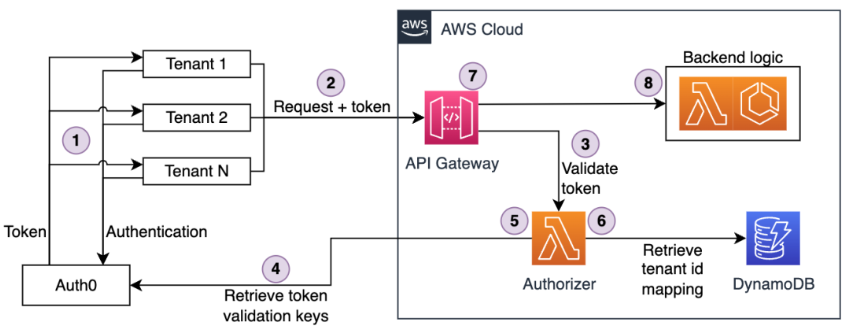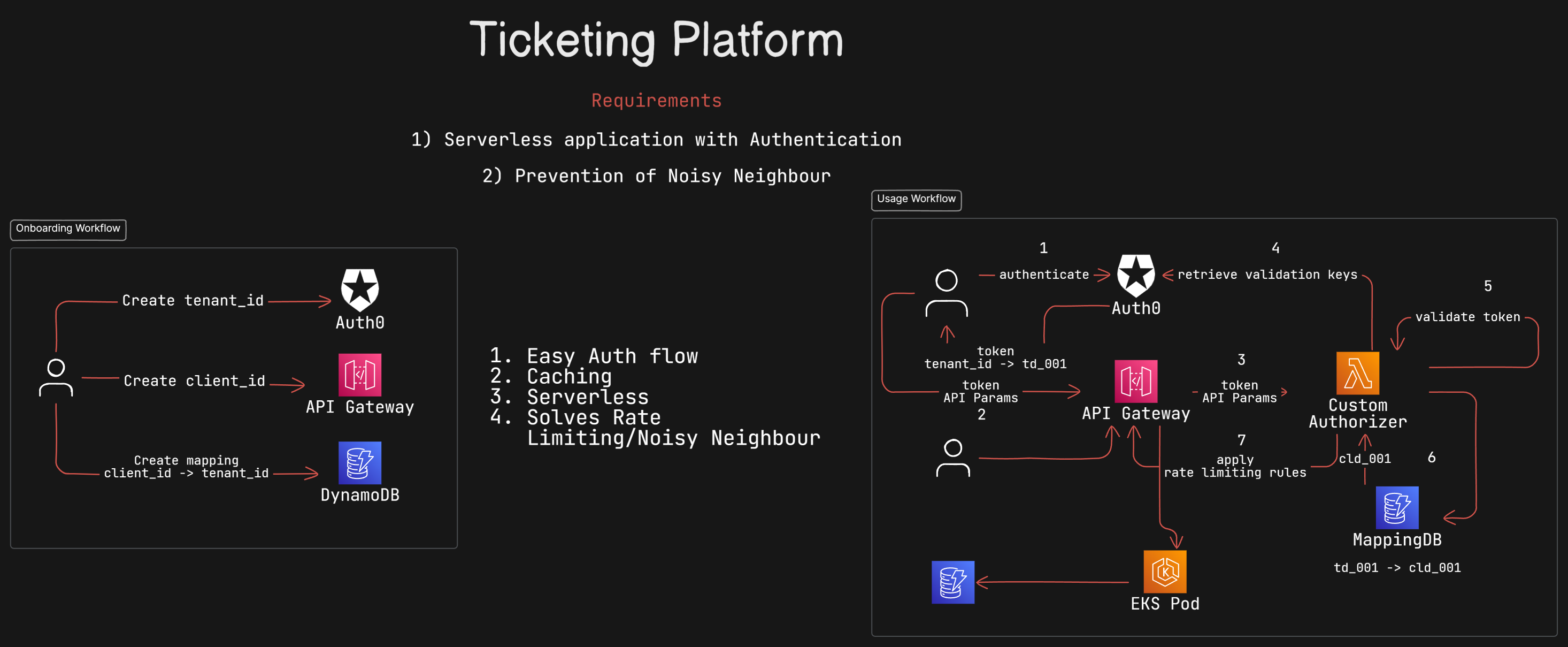Advanced Serverless Authentication and Rate Limiting in Multi-Tenant SaaS Platforms
 Shreyas Ladhe
Shreyas Ladhe
Introduction
While researching authentication and rate limiting strategies for multi-tenant SaaS applications, I came across an insightful AWS blog published on August 14, 2023. The blog detailed how SeatGeek leverages AWS services for handling authentication, authorization, and rate limiting in a serverless environment (AWS Blog). The architecture outlined in the post was fascinating, but I saw room for refinement and improvement.
Inspired by this, I delved deeper into optimizing a serverless ticketing platform by enhancing efficiency, security, and scalability beyond the original design. This article presents a comprehensive analysis of AWS's proposed architecture, followed by a more advanced, optimized design that improves upon its key components.
Analysis of the AWS Architecture

Key Challenges: Authentication, Authorization, and Rate Limiting
The primary challenges faced by SeatGeek included:
Secure authentication and authorization to manage multiple tenants with unique identities.
Mitigation of noisy neighbor effects, ensuring fair allocation of computational resources.
Seamless authentication workflows that integrate efficiently into a serverless environment.
Scalability concerns, requiring a dynamic system that balances performance and security.
AWS-Based Solution Components
SeatGeek's architecture relies on the following AWS services:
Auth0 – Serves as the centralized identity provider (IdP), issuing tokens for authentication.
Amazon API Gateway – Handles incoming API requests and enforces rate limiting.
AWS Lambda (Custom Authorizer) – Validates API requests by checking the authentication tokens.
Amazon DynamoDB (Mapping Database) – Stores mappings between tenant identifiers (
tenant_id) and client credentials (client_id).Amazon Elastic Kubernetes Service (EKS) – Hosts microservices responsible for executing business logic after authentication.
Rate Limiting Mechanisms – Implemented both at API Gateway and Lambda levels to prevent tenants from monopolizing resources.
Custom Architecture for a Serverless Ticketing Platform

Core Architectural Requirements
Building upon AWS's foundational approach, this custom serverless ticketing platform introduces improvements in efficiency, security, and resource allocation:
Seamless serverless authentication that minimizes latency and improves user experience.
Granular multi-tenant support with enhanced rate limiting controls.
Optimized request validation to accelerate API response times.
Auto-scalable design that dynamically provisions resources based on traffic patterns.
Architectural Components
1. Tenant Onboarding Workflow
A new tenant registers through the system, triggering the Auth0 Identity Provider (IdP).
Auth0 assigns a unique
tenant_id, securing the identity for future authentication.API Gateway generates a
client_idassociated with the tenant.The system persists a mapping between
tenant_idandclient_idin Amazon DynamoDB.
2. Request Processing Workflow
The tenant authenticates using Auth0 and receives an OAuth 2.0 access token.
API requests include the
tenant_idand access token in request headers.API Gateway forwards the request to a Custom Authorizer (AWS Lambda function).
The Custom Authorizer retrieves public keys from Auth0 and validates the token.
The system queries DynamoDB to fetch the corresponding
client_id.Rate limiting policies are applied at API Gateway to ensure fair resource distribution.
If validation succeeds, the request is routed to an EKS Pod for business logic execution.
3. Enhanced Rate Limiting Mechanism
API Gateway Rate Limiting
Uses per-tenant rate limits based on predefined quotas.
Prevents excessive API consumption from a single tenant.
Lambda Function Rate Control
Ensures each request undergoes rigorous validation.
Mitigates denial-of-service (DoS) attacks by enforcing execution quotas.
DynamoDB-Based Request Throttling
Stores real-time request counters.
Implements Time-to-Live (TTL) for efficient cleanup of expired request entries.
Prevents abuse by tracking request frequency dynamically, adjusting limits in real-time.
Enhancements Over the AWS Blog Architecture
This custom design introduces key optimizations:
Optimized Authentication Flow – Reduces the number of redundant calls to Auth0 by caching validation keys.
Refined Tenant-Client Mapping – Implements an efficient DynamoDB schema that minimizes read latency.
Improved Noisy Neighbor Mitigation – Enhances API Gateway rate limiting with tenant-specific quotas.
In-Memory Caching Strategies – Reduces authentication overhead using AWS ElastiCache (Redis).
Dynamic Scaling Mechanism – Employs AWS Auto Scaling for EKS to adjust workloads based on API demand.
AI-Driven Rate Limiting – Integrates predictive analytics using Amazon SageMaker to proactively adjust rate limits based on historical usage trends.
Automated Monitoring and Logging – Implements AWS CloudWatch dashboards for real-time visibility into authentication patterns, rate limit breaches, and anomalous activity detection.
Comparative Analysis of Architectures
| Feature | AWS Blog (SeatGeek) | Custom Architecture |
| Identity Provider | Auth0 | Auth0 with caching optimization |
| Request Validation | Lambda Custom Authorizer | Lambda + ElastiCache caching |
| Rate Limiting | API Gateway + DynamoDB | AI-driven rate limiting with SageMaker |
| Scaling Strategy | Static EKS nodes | Dynamic EKS auto-scaling |
| Monitoring | Basic logging | Advanced CloudWatch dashboards |
Conclusion
The AWS blog outlined a robust serverless architecture for authentication and rate limiting within a multi-tenant SaaS platform. The custom architecture presented in this article extends that foundation, emphasizing enhanced efficiency, security, and scalability.
Future iterations could incorporate:
AI-driven traffic pattern analysis for proactive request throttling.
Predictive auto-scaling policies to preemptively allocate resources based on demand trends.
Comprehensive monitoring frameworks using AWS CloudWatch for deeper visibility into API performance and security anomalies.
To become a successful Solutions Architect, one must not only comprehend existing architectures but also possess the analytical skills necessary to refine and optimize them. The ability to critically evaluate and enhance cloud-based solutions is what differentiates an average architect from an exceptional one. This iterative mindset is essential for building scalable, efficient, and secure multi-tenant SaaS platforms in the cloud era.
Subscribe to my newsletter
Read articles from Shreyas Ladhe directly inside your inbox. Subscribe to the newsletter, and don't miss out.
Written by

Shreyas Ladhe
Shreyas Ladhe
I am Shreyas Ladhe a pre final year student, an avid cloud devops enthusiast pursuing my B Tech in Computer Science at Indian Institute of Information Technology Vadodara ICD. I love to learn how DevOps tools help automate complex and recurring tasks. I also love to share my knowledge and my project insights openly to promote the open source aspect of the DevOps community.